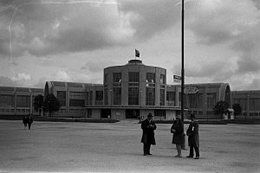
The Brno Exhibition Centre was opened 80 years ago with an exhibition of contemporary culture
 |
The basic program of the exhibition was to showcase and display all that was new and original that had arisen in independent Czechoslovakia since 1918, across a wide spectrum. The exhibition was divided into eight exhibition sections, consisting of 26 fields and exhibited in 69 pavilions. The main pavilion dominated the exhibition, its spaces designated for education, art, and public care for crafts and domestic arts and crafts. Science, culture, and education occupied about a quarter of the exhibition area. Other stalls mapped self-governance, agriculture, and horticulture, as well as the areas of radio and cinema or Brno's exhibition markets. For relaxation, the visitors were attracted by an amusement park. The exhibition also included a district of 16 residential buildings.
One of the biggest hits of the exhibition and its symbol became the model of a mammoth in the pavilion Man and His Family, which was commissioned by the famous Moravian researcher Karel Absolon.
By mid-October 1928, the exhibition had been visited by 2.7 million visitors. With its success, the exhibition in Brno followed the Prague Jubilee Exhibition from 1891. The entire event ultimately ended with a profit of 16 million crowns. Some of the exhibits were preserved and transferred to the Technical Museum in Prague.
The most successful "exhibit" of the exhibition was, however, the exhibition center itself in Brno - Pisárky. In the competition for the urban design of the complex, the proposal by Josef Kalous won among 31 projects, featuring two radiating axes. Leading Czech architects of the time contributed to his concept - among others, Bohuslav Fuchs, Pavel Janák, Josef Gočár, Emil Králík, Jiří Kroha, and Kamil Roškot. Functionality was applied to an unprecedented extent in style here, which has allowed the exhibition center to maintain both functionality and an elegant, modern appearance to this day.
The construction of the exhibition center began in December 1926. In a record time of 14 months, 69 pavilions and other buildings were erected on 36 hectares (with an exhibition area of 30,355 square meters in the pavilions). The landscaping was also mastered, with the main avenues planted with already grown trees.
The Commercial-Industrial Palace made of reinforced concrete and glass (pavilion A, listed as a heritage site), which was the center of the exhibition, was built in 230 days. Its rotunda, with a diameter of 30 meters and a height of 33 meters, was the largest exhibition hall, in the center of which greeted visitors with a life-size statue of President T. G. Masaryk by Otakar Španiel. The main exhibition avenue was closed by the pavilion of the Brno Exhibition Markets, designed by Bohumír Čermák, featuring a 45-meter-high glass observation tower (pavilion G).
The glory of the exhibition center gradually declined in the 1930s. By the end of the war, the area was largely destroyed due to bombing. There were even considerations for its demolition and transformation, for example into an amusement park.
The significance of the exhibition center was revived by the growth of the economy and industrial production at the end of the 1950s. With the successes of the first engineering exhibitions came an investment boom. At the first international engineering fair in 1959, visitors already admired the modern pavilions B, C, and especially pavilion Z - the new dominant feature and symbol of the exhibition center.
The circular "Zetko", with a diameter of 100 meters on the ground floor, featuring a giant dome 37 meters high, and a gross exhibition area of 20,000 square meters, was an avant-garde architectural unique due to the spherical grid shell of the roof (the dome was designed by Professor Ferdinand Lederer from Brno).
The face of the exhibition area is constantly changing according to the needs of exhibitors. The new pavilions built after 1990 also represent modern Czech construction, and overall, the exhibition center in Brno ranks among the most beautiful in Europe due to its architecture.
The English translation is powered by AI tool. Switch to Czech to view the original text source.
1 comment
add comment
Subject
Author
Date
oleee
jiri
26.05.08 10:59
show all comments
Related articles
0
25.05.2023 | The Brno Exhibition Centre was opened 95 years ago by the Exhibition of Contemporary Culture
0
12.12.2020 | Trade Fairs Brno will sell the UMPRUM pavilion for 45 million
0
23.05.2018 | The Brno Exhibition Center was opened 90 years ago by the Exhibition of Contemporary Culture
0
21.08.2017 | A hundred years since the founding of Czechoslovakia will be celebrated in Brno at the exhibition grounds












